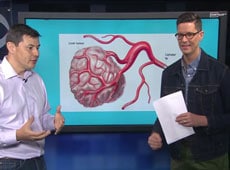What is varicocele embolization?
Varicocele embolization is an interventional radiology procedure used to treat symptomatic varicoceles in the scrotum. Varicoceles are enlarged veins in the scrotum that can cause pain, swelling, and infertility. Men may notice this problem because of visible lumps or twisted veins in the scrotum or because of a dull, recurring pain. Sometimes there are no symptoms and varicoceles are detected during a physical exam or an evaluation for male infertility.
During varicocele embolization, small coils are used to close enlarged gonadal veins which are the source of varicoceles. During the procedure, the interventional radiologist uses a contrast agent and fluoroscopic techniques to visualize blood vessels. The images can be viewed in real time making the procedure fast and effective. See the section Fluoroscopy for more information about this technique.
Similar to varicose veins of the leg, varicoceles are abnormally large and elongated veins inside the scrotum. You may or may not have symptoms. Varicocele embolization is recommended for symptomatic varicoceles and to improve sperm quality for infertile couples. Conditions that might indicate the need for varicocele embolization include:
- Swelling in the scrotum
- Dull or sharp pain in the testicles or scrotum
- Shrunken or underdeveloped testicles
- Issues with fertility
Benefits
- Varicocele embolization is a minimally invasive procedure that can bring rapid relief to symptomatic varicoceles and can be performed as an outpatient procedure. This reduces overall risk, complications, and recovery time.
- The procedure only requires a small incision in the skin. Varicocele embolization avoids the need for open surgery or laparoscopic surgery.
- Studies reveal that the success rate for varicocele embolization is near 90 percent.
Risks
- Varicocele embolization uses a very small dose of radiation, and the benefit from accurate diagnosis and successful treatment far outweighs the risk. Please see ARA’s information on Radiation Safety.
- There is a very small risk for contrast allergy. If you have had an allergic reaction to contrast material in the past, your health care provider may recommend that you take medication for 24 hours before the procedure to reduce risk.
- In very rare cases, the catheterization may injure a vessel, which can cause bleeding or vessel blockage. This may require additional procedures to clear the vessel or stop the bleeding.
- Other complications may include low back pain, inflammation within the scrotum (epididymitis), and phlebitis.
- Varicocele embolization is typically done in an ARA outpatient interventional suite or hospital as an outpatient procedure. The procedure takes about 90 minutes.
- You may be asked to remove all metal and jewelry, and you will be asked to change into a gown.
- Before the exam, a paramedic or technologist will start in intravenous (IV) line in your arm or hand.
- Electrodes may be placed on your chest to monitor your heart function during the procedure.
- You will be positioned comfortably on the exam table. At this point, a dose of sedative may be delivered through the IV to help you relax. The area where the catheter will be inserted may be shaved and will be cleaned and numbed with local anesthetic, which may sting briefly.
- The radiologist will make a tiny nick in your skin and guide the catheter into the vein (the femoral vein in the groin or the jugular vein in the neck), then guide the catheter through the blood vessels until it reaches the area being treated. At this point, contrast material is injected. You may feel a warm sensation as the contrast material enters your bloodstream. Contrast material helps make the vessels appear more clearly on the image.
- A special camera (fluoroscope) will take pictures which can be viewed in real time on a monitor by the interventional radiologist.
- Once the catheter reaches the area to be treated, small coils are deposited to embolize, or close, the enlarged vessel.
- More images may be taken to make sure the embolization was completed effectively.
- When the procedure is finished, the catheter is removed, and pressure applied to the incision site.
- Since you will be sedated, please arrange for a friend or family member to drive you home.
- You may resume your normal activities 8 to 12 hours after the exam. You may resume your normal diet immediately.
- Please let your physician and your scheduler know of all medications you are taking and if you have allergies, especially to iodinated contrast material. Also let your physician and scheduler know about recent illnesses or ongoing medical conditions.
- If you take any blood-thinning medications, aspirin, or products containing aspirin, please contact our office for instructions on discontinuing the medications prior to your procedure.
- You will be asked to remove clothes over the area being examined and to wear a gown.
- If your exam plans include giving you a sedative, you may be instructed not to eat or drink for 6 hours before the exam. Please discuss this with your ARA scheduler to get instructions. You may take scheduled medications with small sips of water.
- Since you will be sedated, please plan to bring a friend or relative to drive you home.
To schedule a consultation about varicocele embolization, call (512) 467-9729 or fill out this consultation form.

 Back to Top
Back to Top